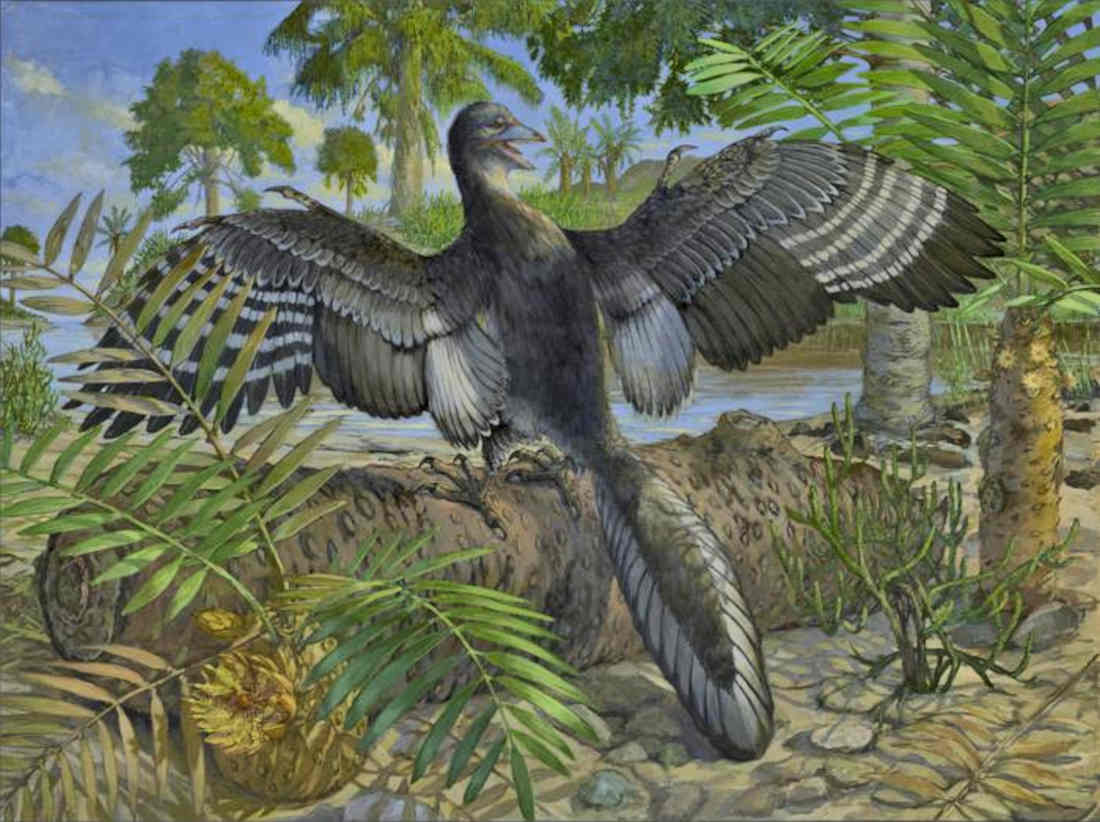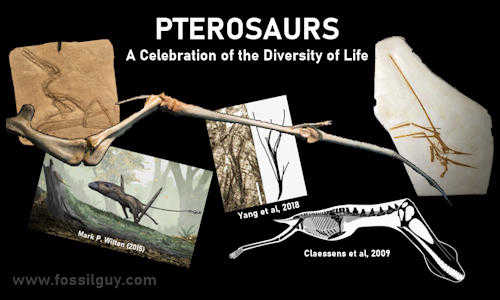Paleontology News
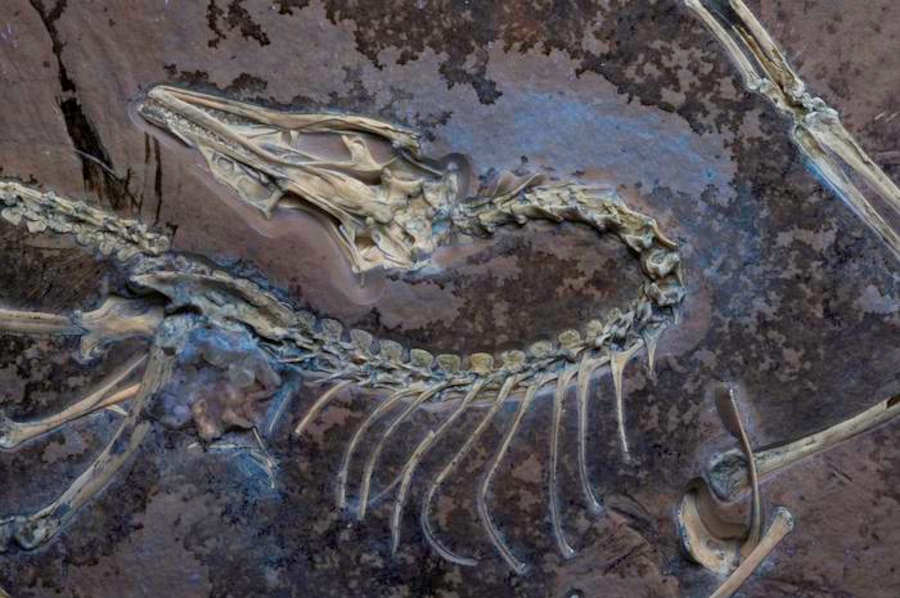
The Chicago Archaeopteryx under UV light to show soft tissues alongside the skeleton. Image Credit: Delaney Drummond 2023 - Field Museum
Wings of Transition: What the Chicago Archaeopteryx Reveals About the Origins of Birds
The newly described Chicago Archaeopteryx fossil offers the most detailed look yet at this iconic early bird, revealing key evolutionary traits related to flight, skull mobility, and soft tissue anatomy through advanced imaging and careful preparation. Read the news story below:
Summary Points
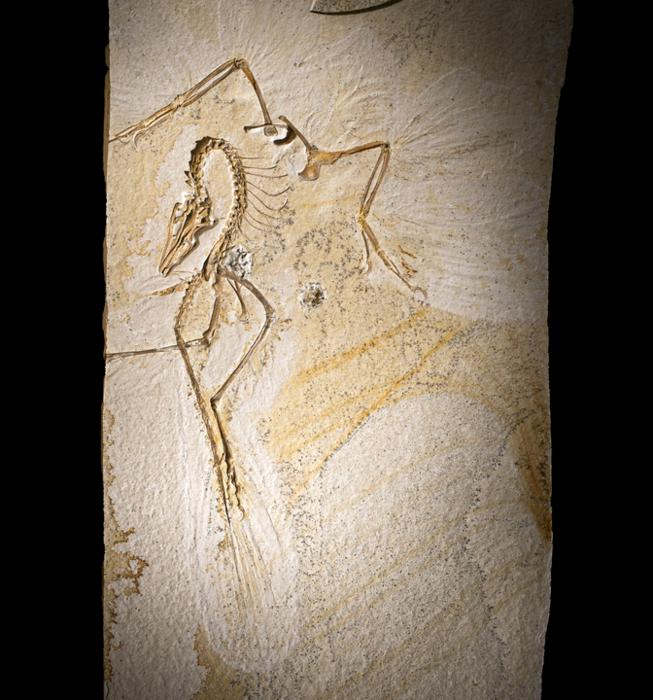
The Chicago Archaeopteryx. Image Credit: Delaney Drummond - (c) Field Museum
The 14th known Archaeopteryx fossil was recently unveiled at the Field Museum in Chicago.
The study is a collaboration between Chinese and American scientists, led by Dr. Hu Han (IVPP, Chinese Academy of Sciences) and Dr. Jingmai O’Connor (Field Museum).
It is the smallest and most complete specimen yet, preserved in 3D with soft tissues and feathers.
Advanced CT scans revealed a nearly intact skull, including a rare view of the palate.
The fossil shows clear signs of a terrestrial lifestyle, with modern bird-like toe pads.
flight feathers were discovered for the first time in Archaeopteryx, suggesting it was capable of powered flight.
The specimen bridges key evolutionary features between non-avian dinosaurs and birds.
This is the first Archaeopteryx fossil to have its entire CT data publicly shared.
Wings of Transition: What the Chicago Archaeopteryx Reveals About the Origins of Birds
This article is based on two news releases by the Field Museum, and the CAS, and the Journal Article (O’Connor, J., Clark, A., Kuo, PC. et al., 2025) from Nature.
A Remarkable Fossil Discovery
The Chicago Archaeopteryx, the 14th known specimen of this iconic species, is offering a fresh look at one of evolution’s most significant creatures. Described in a 2025 study published in Nature, the fossil was acquired by Chicago’s Field Museum in 2022 and made public in 2024. Although Archaeopteryx fossils have been known for over 160 years, this specimen stands out for its completeness, exquisite preservation, and the use of advanced imaging techniques. The research was led by Dr. Jingmai O’Connor of the Field Museum and Dr. Hu Han of the Chinese Academy of Sciences. Their team used high-resolution CT scans and 3D reconstruction to study the fossil in unprecedented detail, revealing soft tissues, bone structures, and feather arrangements that had never been fully documented before.
Unearthing a Tiny, Ancient Dinosaurlike Bird
Like all Archaeopteryx fossils, the Chicago specimen was unearthed from the Solnhofen limestone of southern Germany. Likely discovered before 1990 by a private collector, it remained in private hands until its recent acquisition. This particular individual is the smallest Archaeopteryx known, about the size of a pigeon, and preserved with many bones in near three-dimensional form. The fossil includes soft tissues such as skin, toe pads, and feathers—features that rarely survive fossilization. The team’s painstaking preparation, led by fossil preparator Akiko Shinya, involved more than a year of detailed work. UV light and CT scanning were crucial in distinguishing bones and tissues from the rock matrix, ensuring that delicate features were preserved rather than lost in preparation.
New Clues About the Skull and Evolutionary Relationships
The skull of the Chicago Archaeopteryx is among the most complete ever found and includes a remarkably intact palate. This structure is a key component in the evolution of cranial kinesis, the ability of the upper beak to move independently from the skull—a trait that defines modern birds. The Chicago specimen’s palatal bones are intermediate between those of troodontids (small, bird-like theropods) and more derived Cretaceous birds. This placement provides crucial evidence of how bird skulls evolved from their more rigid theropod ancestors, and it offers a new foundation for biomechanical models of ancient avian feeding and sensory abilities.
Hands, Feet, and a Terrestrial Lifestyle
In addition to its skull, the fossil reveals important clues about how Archaeopteryx interacted with its environment. The morphology of the hands and feet, including preserved soft tissue like toe pads and scales, suggests this animal spent considerable time on the ground. The toe pads in particular resemble those of modern birds that forage on the ground, supporting the idea that Archaeopteryx led a terrestrial or mixed lifestyle—perhaps walking on land, roosting in trees, and climbing when necessary. These findings challenge older assumptions that early birds were primarily arboreal or gliders, suggesting instead a versatile ecology.
Flight-Ready Feathers: The Role of Tertials
One of the most exciting discoveries involves a previously undocumented feature: tertial, or flight feathers, preserved in a member of this species for the first time. These feathers attach to the humerus and ulna and fill the space between the body and the long flight feathers on the wing, helping to form a continuous aerodynamic surface. Their presence in Archaeopteryx but absence in non-avian feathered dinosaurs strengthens the argument that this animal was capable of powered flight. According to O’Connor, tertials are missing in other feathered dinosaurs, whose feathers stop at the elbow—further suggesting those species could not fly, while Archaeopteryx could.
Bridging the Gap Between Dinosaurs and Birds
The significance of the tertials extends beyond this one specimen. Their appearance in Archaeopteryx may represent a flight-related innovation and help support the hypothesis that flight evolved multiple times within feathered dinosaurs. This fossil thus provides rare, physical evidence for the aerodynamic transitions that led to modern avian flight. Its combination of primitive and advanced features confirms that Archaeopteryx occupied a critical evolutionary position: it retained many dinosaurian traits while also possessing clear avian adaptations, including those tied to flight and ecological flexibility.
A Technological Leap for Paleontology
The study of the Chicago Archaeopteryx is also a milestone in paleontological methodology. It is the first complete Archaeopteryx to be fully CT scanned with data made publicly available, and the preparation team used a mix of imaging and chemical analysis to preserve more detail than ever before. Past specimens may have possessed similar features, but lacked the careful preparation and technology needed to reveal them. As a result, this fossil sets a new standard for studying rare and delicate fossils and underscores how new tools can unlock new understanding—even from familiar species.
The Beginning of a New Chapter
As one of the best-preserved and most completely studied Archaeopteryx fossils ever found, the Chicago specimen opens new avenues for research. The fossil will continue to be studied for years to come, and its digital data will be an important resource for researchers worldwide. More than 160 years after its discovery helped validate Darwin’s theory of evolution, Archaeopteryx is once again reshaping our understanding of how dinosaurs became birds.
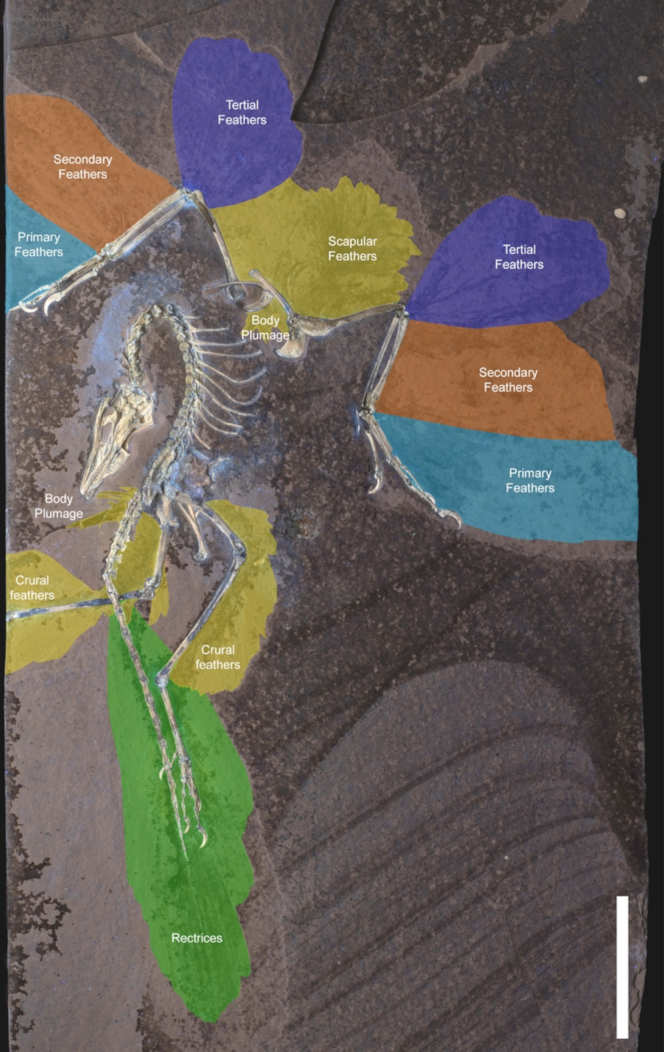
Feather distribution of the Chicago Archaeopteryx. Image Credit: O'Connor et al. Nature
Journal Article:
O’Connor, J., Clark, A., Kuo, PC. et al. Chicago Archaeopteryx informs on the early evolution of the avian bauplan. Nature (2025). DOI:10.1038/s41586-025-08912-4.
Recommended Dinosaur Books and Educational Items:

High quality Dinosaur teeth by Fossilera

